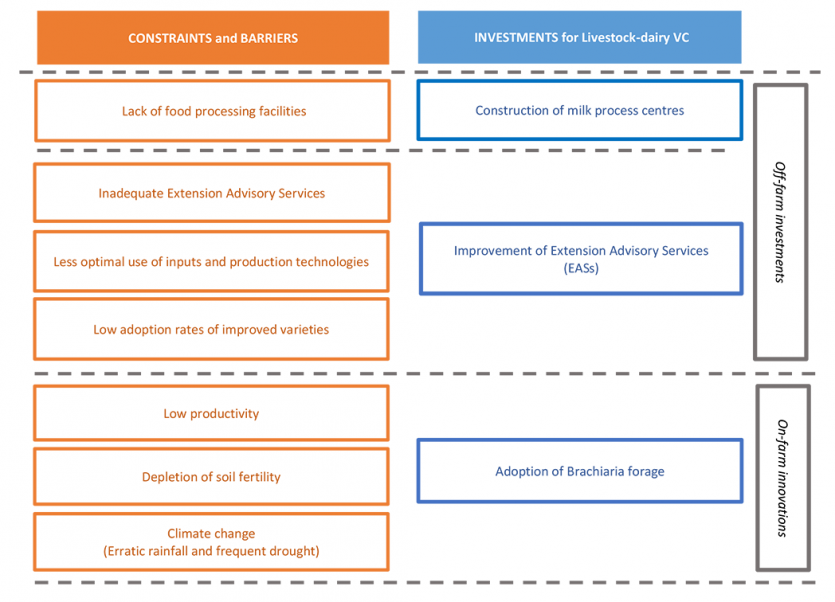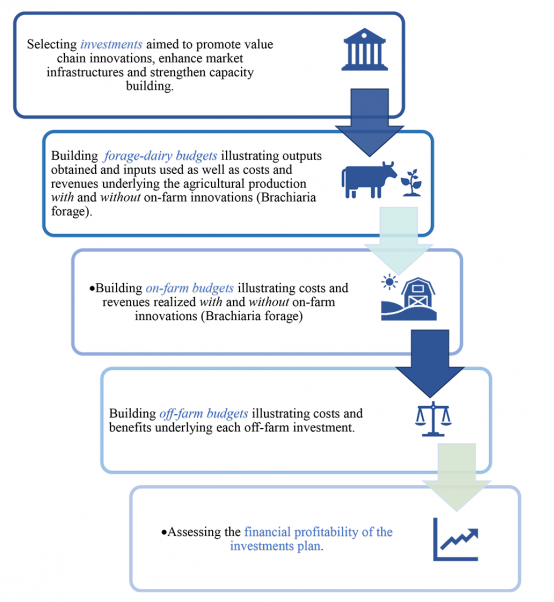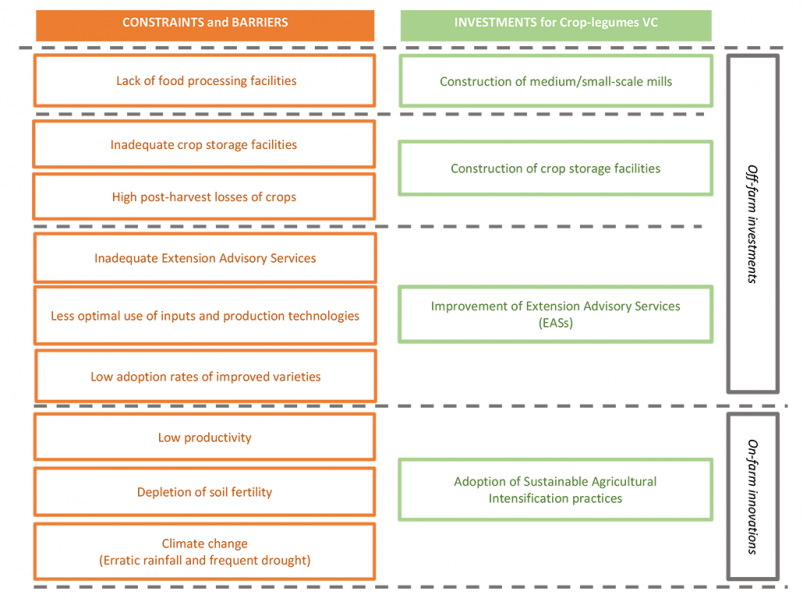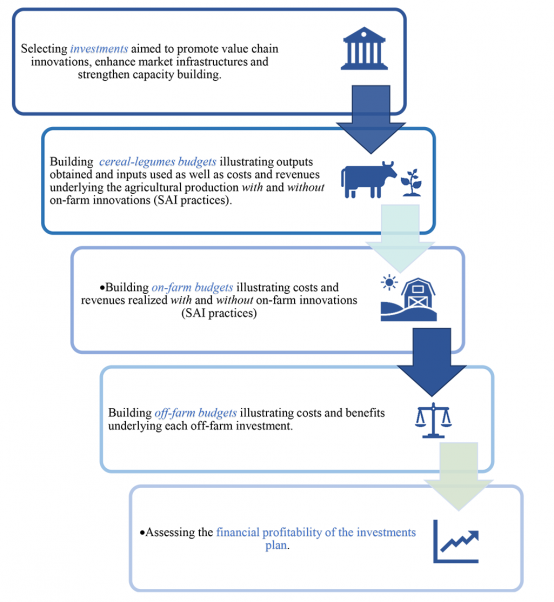PROFITABILITY OF BRACHIARIA FORAGE-LIVESTOCK SYSTEMS
The adoption of Brachiaria forage is known to contribute significantly to ecological restoration and soil erosion control as well as improve the livestock productivity in terms of milk production. The adoption of Brachiaria forage represents the scenario “with innovation” while the use of traditional forages like Napier characterize the scenario “without innovation”.
Specific off-farm investments in processing infrastructure (e.g. milk process centres) and capacity building (e.g. extension advisory services) are proposed as interventions to scale up the InnovAfrica innovations illustrated above, address the link between smallholder farmers and key VC’s actors and develop innovative agri-business models for stakeholders by creating new trade opportunities. A financial analysis is implemented to compute their viability.
Figure 1 illustrates the link existing between the main constraints and barriers faced by small-holder farmers and the selected on-farm and off-farm investments in the Brachiaria forage-livestock.

A financial analysis was implemented to compute the viability of the proposed investments. All the methodological steps followed are illustrated in Figure 2.

With reference to the on-farm innovations adopted in the Brachiaria forage-livestock VC:
- the results obtained in the selected country-case studies appear not uniform.
- Specifically, while in Rwanda the introduction of Brachiaria forage in the farm system increases operating costs with respect to traditional forages (e.g. Napier grass), in Kenya Brachiaria production leads to operating costs decreases, with a consequent reduction of the total production costs.
- Despite such differences, increases in main output quantities (i.e. forage yield and cow milk production) and on-farm revenues lead to gross- and net-incomes increases with respect to traditional forage production.
As regards the off-farm investments, results show that:
- investment costs happen mainly at the initial investment stage. On-farm and off-farm benefits are equal to zero in the first year and increase during the rest of the investments period. This is due to a gradual implementation rate.
- As expected, the incremental benefits from the investment plans are negative in the first two years and become positive in the third. The proposed interventions require at least two years to generate its economic returns.
The computed financial indicators demonstrate the profitability of the investment plans as follows:
- Positive NPVs are found in all country-cases, indicating that benefits outweigh the costs and that the investments generate profits over time.
- Similarly, IRRs are found bigger than discount rates in all the country-cases, confirming the attractiveness of the proposed investments.
- However, significative differences exist depending on the specific country contexts. Also, investments in the forage-dairy chain are found to be on average more profitable and rewarding to farmers than those happening in the cereal-legume production chain.
PROFITABILITY OF CEREAL-LEGUMES INTERCROPPING SYSTEMS
SAI practices aim to overcome constraints such as low productivity, depletion of soil fertility and climate change. They have been introduced to produce more outputs from the same area of land while reducing the negative environmental impacts and, at the same time, increase contributions to natural capital and the flow of environmental services.
They are characterized by
- specific minimal use of external inputs;
- minimal use of technologies that have an adverse impact on the environment and human health;
- harnessing agro-ecological processes (e.g. nutrient cycling, biological nitrogen fixation, allelopathy, predation and parasitism) and
- use of forage varieties and livestock breeds more resilient and with a high ratio of productivity.
The SAI practices considered in the Innovafrica project are the following:
- crop rotation;
- intercropping;
- minimum tillage,
- mulching,
- cover-crops,
- planting pits and
- tied ridging.
The adoption of such practices represents the scenario “with innovation”. On the other hand, the scenario “without innovation” is characterized by the adoption of conventional practices mainly based on ploughing and limited recycling of organic materials.
Specific off-farm investments in processing infrastructure (e.g. medium/small-scale mills), agricultural facilities (e.g. storage), and capacity building (e.g. extension advisory services) are proposed as interventions to scale up the InnovAfrica innovations illustrated above, address the link between smallholder farmers and key VC’s actors and develop innovative agri-business models for stakeholders by creating new trade opportunities.
Figure 1 illustrates the link existing between the main constraints and barriers faced by small-holder farers and the selected on-farm and off-farm investments in the cereal-legumes value chain.

A financial analysis was implemented to compute the viability of the proposed investments. All the methodological steps followed are illustrated in Figure 2.

With reference to the on-farm innovations adopted in the cereal-legume VC, the results show that:
- in all the country-case studies (Malawi, Ethiopia, Tanzania and South Africa) the adoption of SAI practices may increase crop yields and farm revenues;
- despite in some contexts, the adoption of such practices leads to increases in operating costs (Ethiopia and Tanzania) and labour costs (Malawi, Ethiopia, Tanzania and South Africa), on-farm budgets indicate positive gross- and net-incomes which are also higher than those obtained for conventional farming practices.
As regards the off-farm investments, results show:
- investment costs happen mainly at the initial investment stage;
- on-farm and off-farm benefits are equal to zero in the first year and increase during the rest of the investments period. This is due to a gradual implementation rate
- As expected, the incremental benefits from the investment plans are negative in the first two years and become positive in the third;
- the proposed interventions require at least two years to generate its economic returns.
The computed financial indicators demonstrate the profitability of the investment plans as follows:
- Positive NPVs are found in all country-cases, indicating that benefits outweigh the costs and that the investments generate profits over time;
- Similarly, IRRs are found bigger than discount rates in all the country-cases, confirming the attractiveness of the proposed investments;
- However, significative differences exist depending on the specific country contexts.
